» Site Map
» Home Page
Historical Info
» Find Friends - Search Old Service and Genealogy Records
» History
» QAIMNS for India
» QAIMNS First World War
» Territorial Force Nursing Service TFNS
» WW1 Soldiers Medical Records
» Field Ambulance No.4
» The Battle of Arras 1917
» The German Advance
» Warlencourt Casualty Clearing Station World War One
» NO 32 CCS Brandhoek - The Battle of Passchendaele
» Chain of Evacuation of Wounded Soldiers
» Allied Advance - Hundred Days Offensive
» Life After War
» Auxiliary Hospitals
» War Graves Nurses
» Book of Remembrance
» Example of Mentioned in Despatches Letter
» Love Stories
» Autograph Book World War One
» World War 1 Letters
» Service Scrapbooks
» QA World War Two
» Africa Second World War
» War Diaries of Sisters
» D Day Normandy Landings
» Belsen Concentration Camp
» Italian Sailor POW Camps India World War Two
» VE Day
» Voluntary Aid Detachment
» National Service
» Korean War
» Gulf War
» Op Telic
» Op Gritrock
» Royal Red Cross Decoration
» Colonels In Chief
» Chief Nursing Officer Army
» Director Army Nursing Services (DANS)
» Colonel Commandant
» Matrons In Chief (QAIMNS)
Follow us on Twitter:

» Grey and Scarlet Corps March
» Order of Precedence
» Motto
» QA Memorial National Arboretum
» NMA Heroes Square Paving Stone
» NMA Nursing Memorial
» Memorial Window
» Stained Glass Window
» Army Medical Services Monument
» Recruitment Posters
» QA Association
» Standard
» QA and AMS Prayer and Hymn
» Books
» Museums
Former Army Hospitals
UK
» Army Chest Unit
» Cowglen Glasgow
» CMH Aldershot
» Colchester
» Craiglockhart
» DKMH Catterick
» Duke of Connaught Unit Northern Ireland
» Endell Street
» First Eastern General Hospital Trinity College Cambridge
» Ghosts
» Hospital Ghosts
» Haslar
» King George Military Hospital Stamford Street London
» QA Centre
» QAMH Millbank
» QEMH Woolwich
» Medical Reception Station Brunei and MRS Kuching Borneo Malaysia
» Military Maternity Hospital Woolwich
» Musgrave Park Belfast
» Netley
» Royal Chelsea Hospital
» Royal Herbert
» Royal Brighton Pavilion Indian Hospital
» School of Physiotherapy
» Station Hospital Ranikhet
» Station Hospital Suez
» Tidworth
» Ghost Hunt at Tidworth Garrison Barracks
» Wheatley
France
» Ambulance Trains
» Hospital Barges
» Ambulance Flotilla
» Hospital Ships
Germany
» Berlin
» Hamburg
» Hannover
» Hostert
» Iserlohn
» Munster
» Rinteln
» Wuppertal
Cyprus
» TPMH RAF Akrotiri
» Dhekelia
» Nicosia
Egypt
» Alexandria
China
» Shanghai
Hong Kong
» Bowen Road
» Mount Kellett
» Wylie Road Kings Park
Malaya
» Kamunting
» Kinrara
» Kluang
» Penang
» Singapore
» Tanglin
» Terendak
Overseas Old British Military Hospitals
» Belize
» Falklands
» Gibraltar
» Kaduna
» Klagenfurt
» BMH Malta
» Nairobi
» Nepal
Middle East
» Benghazi
» Tripoli
Field Hospitals
» Camp Bastion Field Hospital and Medical Treatment Facility MTF Helmand Territory Southern Afghanistan
» TA Field Hospitals and Field Ambulances
The German Advance World War One Spring 1918
During the Spring of 1918, there was a pivotal point of the First World War when the German Army began their advance. It affected nurses like Katherine Evelyn Luard who had enlisted in Queen Alexandra's Imperial Military Nursing Reserve (QAIMNSR) on 6 August 1914, two days after the British Government declared war on Germany. She saw service throughout the Great War.
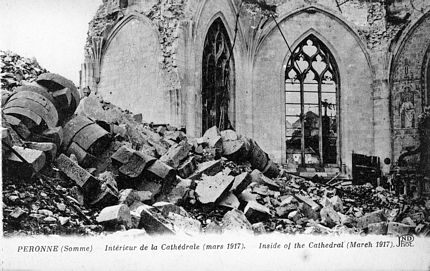
In the first year of the war she was a sister on the ambulance trains in France and Belgium before being posted close to the front line to Field Ambulance No.4. Subsequently she was sister-in-charge of a number of Casualty Clearing Stations.
The German Offensive of spring 1918 was a series of German attacks along the Western Front. With Russia now out of the war, Germany was able to redeploy troops to the Western Front which was imperative for the Germans to advance before the arrival of the American troops. They called this movement the Ludendorff Offensive and it began on the 21st March. These would be the deepest advances seen by either enemy since the first year of the Great War.
On 6 February 1918 Kate Luard rejoined No.32 CCS where once again she was responsible for setting this up in a new location in anticipation of a German offensive. As the Germans advanced, patients and staff of two CCSs where she was sister-in- charge would have to be evacuated.
In chapter 6 of her book Unknown Warriors she vividly describes the events around the German advance in her letters home.
Abbeville and Nampes, February 6th to April 6th 1918
With the 5th Army (Sir Hubert Gough)
LETTERS FROM MARCHÉLEPOT
Wednesday, February 6th 1918. Abbeville. Orders came the day before yesterday to report here, and I find it is for my own Unit, at a place behind St Quentin – a line of country quite new to me. None of my old staff are coming but a new brood of chickens awaits me here and I take three up with me to-morrow. In a new Camp after a move there is nothing to eat out of and nothing to sit on, and it’s the dickens starting a Mess and equipping the Wards at once. They sent me all the 60 miles in a car.
Thursday, February 7th. Marchélepot, south of Péronne. 5th Army. We left Abbeville at 9 p.m. by train to Amiens and got there to find two Ambulances waiting for us. The rest of the run was through open wide country and all the horrors and desolation of the Somme ground, to this place – Marchélepot. There is a grotesque skeleton of a village just behind us, and you fall over barbed wire and in to shell- holes at every step if you walk without light after dark. There is no civil population for miles and miles; it is open grassland – a three years’ tangle of destruction and neglect. All the C.C.S.’s are in miles of desolation behind the lines.
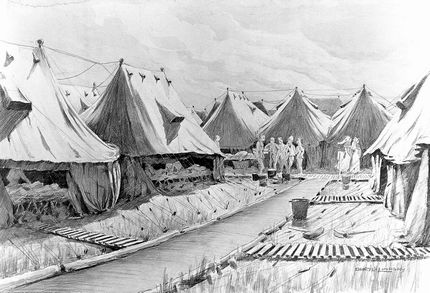
Wounded at CCS, drawing Wellcome Library.
The Colonel and the Officers’ Mess gave us a cheery welcome, and the orderlies are all beaming and looking very fit. I’m thankful that only three Sisters came with me as we found no kitchen, no food, no fire and only some empty Nissen huts, but the Sisters of the C.C.S. alongside have fed and warmed us … sleeping comfortably on our camp beds in one of the Nissen huts and shall have the kitchen started to-morrow. The Hospital has only been dug in since Sunday week – shell holes had to be filled in and grass cut before tents could be pitched or huts put up.
Follow us on Facebook, Instagram and Twitter.
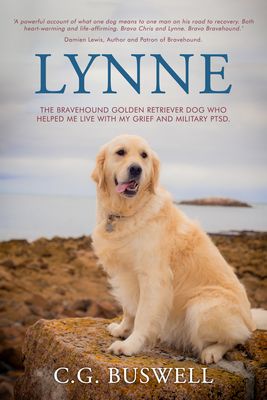
My PTSD assistance dog, Lynne, and I have written a book about how she helps me with my military Post Traumatic Stress Disorder, anxiety, and depression. I talk about my time in the QAs and the coping strategies I now use to be in my best health.
Along the way, I have had help from various military charities, such as Help for Heroes and The Not Forgotten Association and royalties from this book will go to them and other charities like Bravehound, who paired me with my four-legged best friend.
I talk openly about the death of my son by suicide and the help I got from psychotherapy and counselling and grief charities like The Compassionate Friends.
The author, Damien Lewis, said of Lynne:
"A powerful account of what one dog means to one man on his road to recovery. Both heart-warming and life-affirming. Bravo Chris and Lynne. Bravo Bravehound."
Download.
Buy the Paperback.
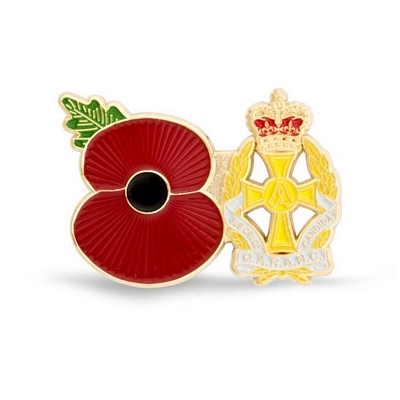
This beautiful QARANC Poppy Pin Badge is available from the Royal British Legion Poppy Shop.
For those searching military records, for information on a former nurse of the QAIMNS, QARANC, Royal Red Cross, VAD and other nursing organisations or other military Corps and Regiments, please try Genes Reunited where you can search for ancestors from military records, census, birth, marriages and death certificates as well as over 673 million family trees. At GenesReunited it is free to build your family tree online and is one of the quickest and easiest ways to discover your family history and accessing army service records.
More Information.
Another genealogy website which gives you access to military records and allows you to build a family tree is Find My Past which has a free trial.
Saturday, February 16th. I expect you’re having about 20 degrees of frost as we are here. Everything in your hut at night, including your own cold body, freezes stiff as iron, but there is a grand sun by day and life is possible again. The patients seem to keep warm enough in the marquees with blankets, hot bottles and hot food, but it is a cold job looking after them.
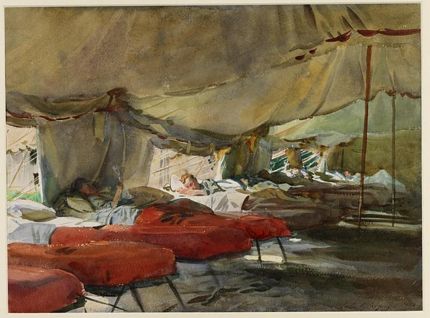
Marquee tent CCS World War One John Singer Sargent painting.
Fritz has begun his familiar old games. Yesterday he bombed all round, but nothing on us. We are wondering how long our record of no casualties will stand: we are a tempting target, and have no large Red Cross on the ground, and no dug-outs, elephants [small dug-outs reinforced with corrugated iron] or sand bags.
This afternoon I went to Péronne. It was once a beautiful town with a particularly lovely Cathedral Church, white and spacious; only some walls and one row of pillars are left now. It is much more striking seeing a biggish town with its tall houses stripped open from the top floor downwards and the skeleton of the town empty, than even these poor villages, in rubbly heaps.
Sunday, February 17th. Terrific frost still. Drumfire blazing merrily East. I have been trying to draw these ruins. Nothing else of this 15th Century white stone church was visible from where I stood on a heap of bricks. It is quite like it [her sketch], especially the thin tottery bit on the right.
On the other side of my heap of bricks I then found an Official War Office artist [Professor William Rothenstein] drawing it too, and we made friends over the ruins and the War.
Monday, February 25th. There is a cold rough gale on to-day, which is a test of our newly pitched Wards and of our tempers. Work is in full swing …. The Colonel knowing my passion for solitude has got me an Armstrong Hut as at Brandhoek and Warlencourt, instead of a quarter Nissen like the rest. It is lined with green canvas and has a wee coal stove and odds and ends of brown linoleum on the floor – all three luxuries I’ve never had before. It looks across the barbed wire and shell-holes straight on to the ruins and the Church.
A terrific bombardment began at 9.30 this evening. We have seen a good deal of Professor Rothenstein. He brought his drawings over to our mess to see.
February 28th. I suppose the newspaper men have long ago got the opening lines of their leaders ready with, “the long expected Battle Wave has rolled up and broken at last, and the Clash of two mighty Armies has begun” etc.etc. It may not be long until they can let it go. Yesterday the C.O.’s of C.C.S.’s of this Army were summoned to a Conference at the D.M.S.’s [Director of Medical Services] Office and given their parts to play. We have arranged accordingly and proceeded in all Departments to indent for Chloroform, Pyjamas, Blankets, Stretchers, Stoves, Hot Water Bottles and what not. The R.E. [Royal Engineers] are working rapidly; Nissen Huts springing up like mushrooms, electric light and water laid on, bath houses concreted, boilers going, duckboards down, and Reinforcements of all ranks arriving. A train is coming to clear the sick to-morrow.
Saturday, March 2nd. Nothing doing so far. Everyone is posted to his right station for Zero and meanwhile the usual routine carries on. To-day there is the most poisonous blizzard. The thin canvas walls of my wee hut are like brown paper in this weather, this violent icy wind blows the roof and walls apart and layers of North Pole and snow come knifing in …
Monday, March 4th. A mighty blizzard snowstorm has covered us and the Boche and there is nothing doing here. Later. the DMS has just been around again with more warnings; and consequently renewed preparations for Zero.
I’ve got some primroses growing in a blue pot, grubbed up out of a ruined garden before the snow. The only way of getting in to my Armstrong Hut at first was across a plank over a shell- hole. The R.E. are fortifying our quarters against bombs. We take in every other day and evacuate about every four days – almost entirely medical cases.
(Zero)
Friday, March 22nd. A ghastly uproar began yesterday, Thursday morning, March 21st. The guns bellowed and the earth shook. Fritz brought off his Zero like clockwork at 4.20 a.m. and in one second plunged our front line in a deluge of High Explosive, gas and smoke, assisted by a thick fog of white mist. Our gunners were temporarily knocked out by gas but soon recovered and gave them hell, which caught their first infantry rush, but they came on and advanced a mile. We suddenly became a front line C.C. S. and the arrival of the wreckage began, continued and has not ended. We began about 9.30 with our usual 14 Sisters and by midnight we numbered 40 as at Brandhoek. Only two Ambulance Trains have come to evacuate the wounded, and the filling up continues. The C.O. and I stayed up all night and to-day, and we have now got people into the 16-hours-on-and-8-off routine in the Theatre etc. We had 102 gassed men in one ward, but only 4 died. Ten girl chauffeurs drove up in the middle of the night with five Operating teams from the Base.
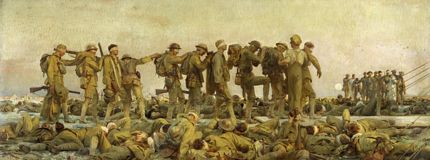
‘Gassed’ oil painting by John Singer Sargent RA 1918 – Imperial War Museum
Friday night, 11 p.m. Just off to bed after 40 hours full steam ahead. Everything and everybody is working at very high pressure and yet it makes little impression on the general ghastliness. This is very near the battle and gets nearer; there are fires on the skyline and to-night bombs are dropping like apples on the country around. The artillery roar has been terrific to-day. Good-night.
Palm Sunday, March 24th, 9 a.m. Amiens. The night before last after writing to you, things looked a bit hot … and the map was altering every hour for the worse … ours was the place where they broke through and came on with their guns at a great pace. All the hot busy morning wind-up increased, and faces looked graver every hour. The guns came nearer, and soon Field Ambulances were behind us and Archies [anti-aircraft guns] cracking the sky with their noise. We stopped taking in because there were no Field Ambulances, and we stopped operating because it was obvious we must evacuate everybody living or dying, or all be made prisoners if anybody survived the shelling that was approaching. Telephone communication with the D.M.S. was more off than on, and roads were getting blocked for many miles, and the railway also. We had a1000 patients until a train came in at 9 a.m. and took 300. Every ward was full and there were two lines of stretchers down the central duck-walk; we dressed them, fed them, propped them up, picked out the dying at intervals as the day went on, and waited for orders, trains, cars or lorries or anything that might turn up. At 10 a.m. the Colonel wanted me to get all my 40 Sisters away on the Ambulance Train, but as we had these hundreds of badly wounded, we decided to stay …
At mid-day the Matron-in-Chief turned up in her car from Abbeville and came to look out for her 80 Sisters – 40 with me and 40 at the other C.C.S. A made-up temporary train for wounded was expected, and we were to go on whichever Transport turned up first and scrap all our kit except hand-baggage. … the Resuscitation Ward was of course indescribable and the ward of penetrating chests was packed and dreadful. Some of the others died peacefully in the sun and were taken away and buried immediately.
At about 5 p.m. the Railway Transport Officer of the ruined village produced a train with 50 trucks of the 8 chevaux or 40 hommes pattern, and ran alongside the Camp; not enough of course for the wounded of both Hospitals but enough to make some impression. Never was a dirty old empty truck-train given a more eager welcome or greeted with more profound relief. The 150 walking cases were got into open trucks, and the stretchers quickly handed into the others, with an Orderly, a pail of water, feeders and other necessaries in each. One truck was for us, so I got a supply of morphia and hypodermics to use at the stoppages all down the train. Then orders came from the D.M.S. that Ambulance Cars were coming for us, so the Medical Officers took the morphia and most of our kit. There were 300 stretcher cases left but another train was coming for them. The Sister in charge of the other C.C.S. told me Rothenstein [Official War artist William Rothenstein whom Kate met when they were both sketching Péronne Cathedral] was helping in the Wards like an orderly.
The Boche was 4 miles this side of Ham, just in to Péronne, and 3 miles from us – 13 miles nearer in 2½ days. I am glad I have seen Péronne. The 8th Warwicks marched in on March 19th 1917. The Germans will take down our notice board on March 23rd 1918 and put up theirs.
German army reserves advancing through St Quentin 1918
We got off in 4 Ambulance Cars escorted by three Motor Ambulance Convoy Officers. They had to take us some way round over battlefields and ghastly wrecked woods and villages, as he was shelling the usual road heavily between us and our destination (Amiens). We rook five hours getting there owing to the blocked state of the roads, with Divisions retreating and Divisions reinforcing, French refugees, and big guns being trundled into safety. He chose that evening to bomb Amiens for four hours.
Sunday, March 24th. The Stationary Hospital people here (Amiens) were extraordinarily kind and gave us each a stretcher, a blanket and a stretcher-pillow in an empty hut. They had not the remotest idea they would be on the run themselves in a day or two.
Monday, March 25th. 10.30 p.m. Abbeville. It is in Orders that no one may write any details of these few days home yet, so I am keeping this to send home later, but writing it up when I can.
Yesterday afternoon I dug out Colonel Thurston, A.D.M.S. Lines of Communication, and asked him for transport from Amiens to Abbeville. On the Station was a seething mass of British soldiers and French refugees. The Colonel had brought the last 300 stretcher cases down the evening before in open trucks with all the M.O.s [Medical Officers] and personnel. Our wounded were lying in rows along the platform with our Orderlies; they had been in the trucks all night and all day. Some had died; the Padre was burying the others in a field with a sort of running funeral, up to the time they left. They were taken straight to their graves as they died. Now our C.C.S. has no equipment, we shall all, C.O.s, M.O.s, Sisters and men, be used elsewhere.
Wednesday night, 27th. Yesterday I was sent up to No.2 Stationary Hospital to do Assistant Matron by Miss McCarthy [Matron in Chief] and we’ve had a busy day, admitting and evacuating.
Saturday, Easter Eve, March 30th 1918. Yesterday evening Miss McCarthy turned me into a Railway Transport Officer at the Railway Station, and it is the most absolutely godless job you could have. You must have command of a) the French language, b) your temper, c) any number of Sisters and V.A.D.s, d) every French porter you can threaten or bribe, e) the distracted R.T.O. and his clerks.
No mail has reached me since we cleared out this day week; do write soon to No.2 Stationary Hospital. I am quite fit.
Easter Monday, April 1st. It has been a dazzling spring day after the heavy rain – spent as usual at the Station – not as R.T.O. this time but as A.M.F.O. (Army Military Forwarding Officer). The day after I last wrote to you, I had a 24 hours’ shift of R.T.O. … puddling about the platforms in the cold and wet. There are no waiting rooms, and the place was a seething mass of refugee families, and French soldiers and my herds of Sisters and kits. But they all got safely landed in their right trains and no kit lost.
Easter Tuesday. Had a very busy day at Triage as A.M.F.O. with my fatigue party fetching and loading kit. And a message came through from Miss McCarthy this evening – was I ready and fit for another C.C.S.? The answer was in the Affirmative.
Wednesday, April 3rd. Letters at last, joy of joys. The Times man is right … and it is all the things he has to leave out of his accounts, the little things officers and men from the Line tell us, that would show you why. And there are weeks of strain ahead …
Saturday night, April 6th. All your letters of the first day of the Battle are coming in. I didn’t quite realise you’d be really worrying. It came so suddenly, and running the wounded and the Sisters gave one no time at all to think – I couldn’t have let you know any sooner. We are plunged in work just now. Every available man has had to be put into the Wards – all the Clerks, Assistant Matron – everyone but the Cook and mess V.A.D.s. I am running two ramping Wards and everyone else is at full stretch. R.T.O. and A.M.F.O. are finished for the time being. All these three Hospitals are understaffed just now and are doing C.C.S. work. We get the men practically straight out of action …
Friday, April 12th. Nampes. Orders came for me on Wednesday to take over this C.C.S. [No.41] at Nampes. It is an absolutely divine spot, south of Amiens. The village is on a winding road, with a heavenly view of hills and woods, which are carpeted with blue violets and periwinkles and cowslips, and starry with anemones. The blue of the French troops in fields and roads adds to the dazzling picture but inside the tents are rows of ‘multiples’ and abdominals, and heads and moribunds, and teams working day and night in the Theatre, to the sound of frequent terrific bombardments. It has never been so incongruously lovely all round.
This is the place where four derelict Casualty Clearing Stations amalgamated and got to work during the Retreat, without Sisters. Now it is run as one with a huge collection of Medical Officers and Orderlies and Chaplains from Units out of action, and with odds and ends of saved equipment. It is still very primitive with no huts and no duckboards and only stretchers, with not many actual beds, but it is quite workable.
The patients are evacuated as quickly as possible, and the worst ones remain to be nursed here. Of course, the rows of wooden crosses are growing rather appalling, but some lives are being saved.
We live four in a marquee in a field below the road and have daisies growing under our beds, no tarpaulins or boards. I’ve acquired a tin basin and a foot of board on two petrol tins for a wash-stand and am quite comfortable. Our compound has five marquees. French Gunners stray in and sleep on the grass all round us, and a constant stream of Poilus [French WW1 infantrymen] passes up and down the road. It is very noisy at night. The Cathedral has had two shells in it.
We live on boiled mutton every day twice a day: tea, bacon, bread and margarine in ample quantities does the rest. Our Mess Cookhouse is four props and some strips of canvas; three dixies, boiling over a heap of slack between empty petrol tins, is the Kitchen Range, in the open. We get a grand supply of hot water from two Sawyer boilers under the tree. The French village does our laundry.
Sunday, April 14th. He [the Germans] is at Merville, and what next I wonder? Here we are holding him all right, but each night of uproar one wonders when we’ll next be on the road again. The weather has changed and the dry, sunny valley has become a chilly, windy quagmire. There are no fires anywhere and very little oil for the lamps; it is very difficult to keep the men warm, and the crop of wooden crosses grows daily.
April 22nd. We are on the move again. The patients left to-day and the tents are down this evening. I expect we shall go to Abbeville, while they dig themselves in at the new site North of Amiens. Everything is very quiet here, except occasional violent artillery duels and bomb dropping at night.
Tuesday, 23rd. A month since we up and ran away from Jerry. It is Abbeville, and we are sitting on our kit waiting for transport. I wonder how black it looked in England on Saturday week, when Haig said “We have our backs to the wall” – worse than close to, probably.
Allied Advance WWI - The Hundred Days Offensive
Read more about Kate at kateluard.co.uk where there are more diary extracts.

Former Royal Air Force Regiment Gunner Jason Harper witnesses a foreign jet fly over his Aberdeenshire home. It is spilling a strange yellow smoke. Minutes later, his wife, Pippa, telephones him, shouting that she needs him. They then get cut off. He sets straight out, unprepared for the nightmare that unfolds during his journey. Everyone seems to want to kill him.
Along the way, he pairs up with fellow survivor Imogen. But she enjoys killing the living dead far too much. Will she kill Jason in her blood thirst? Or will she hinder his journey through this zombie filled dystopian landscape to find his pregnant wife?
The Fence is the first in this series of post-apocalyptic military survival thrillers from the torturous mind of former British army nurse, now horror and science fiction novel writer, C.G. Buswell.
Download Now.
Buy the Paperback.
If you would like to contribute to this page, suggest changes or inclusions to this website or would like to send me a photograph then please e-mail me.

Free Book.
The death of the Brotherhood will be avenged.
RAF gunner Jason Harper and a team of Special Air Service operators are enraged after the death of their brothers by a terrorist drone strike. They fly into south-eastern Yemen on a Black-op mission to gather intelligence and avenge the death of their comrades.
Can they infiltrate the Al-Queda insurgents' camp, stay undetected, and call down their own drone missile strike and get home safely?
Will they all survive to fight another day?
Operation Wrath is a free, fast-paced adventure prequel to the non-stop action The Fence series by military veteran author C.G. Buswell.
Download for free on any device and read today.
This website is not affiliated or endorsed by The Queen Alexandra's Royal Army Nursing Corps (QARANC) or the Ministry of Defence.
» Contact
» Advertise
» QARANC Poppy Pin
» Poppy Lottery
» The Grey Lady Ghost of the Cambridge Military Hospital Novel - a Book by CG Buswell
» The Drummer Boy Novel
» Regimental Cap Badges Paintings
Read our posts on:
Offers
» Army Discounts
» Claim Uniform Washing Tax Rebate For Laundry
» Help For Heroes Discount Code
» Commemorative Cover BFPS 70th anniversary QARANC Association

Present Day
» Become An Army Nurse
» Junior Ranks
» Officer Ranks
» Abbreviations
» Nicknames
» Service Numbers
Ministry of Defence Hospital Units
» MDHU Derriford
» MDHU Frimley Park
» MDHU Northallerton
» MDHU Peterborough
» MDHU Portsmouth
» RCDM Birmingham
» Army Reserve QARANC
Photos
» Florence Nightingale Plaque
» Photographs
Uniform
» Why QA's Wear Grey
» Beret
» Army Medical Services Tartan
» First Time Nurses Wore Trousers AV Anti Vermin Battledress
» TRF Tactical Recognition Flash Badge
» Greatcoat TFNS
» Lapel Pin Badge
» Army School of Psychiatric Nursing Silver Badge
» Cap Badge
» Corps Belt
» ID Bracelet
» Silver War Badge WWI
» Officer's Cloak
» QAIMNSR Tippet
» QAIMNS and Reserve Uniform World War One
» Officer Medal
» Hospital Blues Uniform WW1
Events
» Armed Forces Day
» The Nurses General Dame Maud McCarthy Exhibition Oxford House London
» Edinburgh Fringe Stage Play I'll Tell You This for Nothing - My Mother the War Hero
» Match For Heroes
» Recreated WWI Ward
» Reunions
» Corps Day
» Freedom of Rushmoor
» Re-enactment Groups
» Military Events
» Remembrance
» AMS Carol Service
» QARANC Association Pilgrimage to Singapore and Malaysia 2009
» Doctors and Nurses at War
» War and Medicine Exhibition
» International Conference on Disaster and Military Medicine DiMiMED
» QA Uniform Exhibition Nothe Fort Weymouth
Famous QA's
» Dame Margot Turner
» Dame Maud McCarthy
» Lt Col Maureen Gara
» Military Medal Awards To QAs
» Moment of Truth TV Documentary
» Sean Beech
» Staff Nurse Ella Kate Cooke
Nursing
Nursing Jobs Vacancies UK
International Nurses Day
International Midwife Day
Info
» Search
» Site Map
» Contact
» Other Websites
» Walter Mitty Military Imposters
» The Abandoned Soldier
We are seeking help with some answers to questions sent by readers. These can be found on the Army Nursing page.
» Find QA's
» Jokes
» Merchandise
» Mugs
» Personalised Poster
» Poppy Badges
» Stamp
» Teddy Bears
» Pin Badges
» Wall Plaques
» Fridge Magnet

